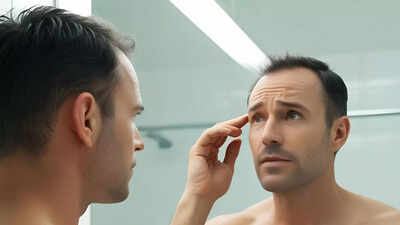Trending
This 1990s drug can help you regrow your hair, suggest researchers: Know how to use it
Dermatologists are studying low-dose minoxidil pills for hair growth, with positive results in recent studies. Low-dose minoxidil appears to improve blood flow to hair follicles, prolonging the growth phase. Research showed significant hair re-growth for both men and women. This pill is easier to use than the topical solution, showing effective digestion by the gut.
Dermatologists are currently focused on an old drug, that was prevalent in the 1990s, for hair growth. Low-dose minoxidil pills are believed to work by increasing the blood flow towards hair follicles and possibly prolonging the hair cycle’s anagen i.e. the growth phase.

Image Credits: iStock
In a published in the journal Jama Dermatology, consumption of low-dose oral minoxidil (LDOM) on hair growth was tested to see if it should be prescribed to patients with hair loss. A total of 43 hair loss specialist dermatologists from 12 countries participated in a modified Delphi process and consensus was reached if at least 70% agreed or strongly agreed on a 5-point Likert scale. The results stated direct supporting benefits of low-dose minoxidil to hair growth.
In another published in the National Library of Medicine, the efficiency of 5mg oral minoxidil for men with androgenetic alopecia was tested. Researchers concluded that 43% of the patients had excellent results in hair growth. In another study by Dr Paulo Müller Ramos, the effects of 1mg of Oral Minoxidil (pills) in the treatment of female pattern hair loss was compared to 5% topical minoxidil solution, and the results were similar. Both the studies suggested that oral minoxidil has proven positive effects on hair re-growth. “By increasing blood flow to the scalp it signals hairs to stay in their growth phase for longer,” said Dr. Adam Friedman, chair of dermatology at George Washington University. “We’re trying to keep those hairs in that growth phase as long as possible.”

Image Credits: Canva
Dermatologists are of the belief that minoxidil works better as a pill. At a chemical level, the pill is more quick in digestion by the gut than the solution being absorbed by the hairline. Additionally, swallowing a pill once a day is easier for patients than applying a solution a number of times a day.

Minoxidil was developed in the 1970s to help treat high blood pressure, but researchers noticed that the people consuming the drug experienced increased hair growth as a side effect. Known by the brand name Rogaine, it was approved by the Food and Drug Administration in 1988, the first drug to win the agency’s endorsement for male pattern baldness. In 1991, a lower dosage was approved for women and gradually, the pill went on to gain fame.
End of Article
FOLLOW US ON SOCIAL MEDIA
Visual Stories
Tired of too many ads?










